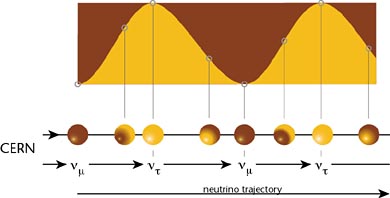| 1. The scientific basis of the CNGS project |
| Up to now, neutrino experiments have been limited to the perimeter of CERN’s Meyrin site, thus to relatively small distances. A recent discovery in Japan, however, shows that a "change in the nature" of neutrinos - oscillation between two types of neutrino - could occur if these particles had a long enough time-of-flight (i.e. trajectory). To confirm that this is really a neutrino oscillation and to investigate the phenomenon further, a particle beam (of neutrinos) from CERN would be linked to detectors located far from the Laboratory, and this for the first time in CERN’s history. |
| Figure 2: Illustration of nm — nt oscillations (a pure nm beam is produced at CERN and directed towards Gran Sasso) |
| 1.2 The
underground laboratory at Gran Sasso (Italy) The underground laboratory at Gran Sasso (LNGS), 120 kilometres from Rome, is one of the facilities belonging to the INFN, the Italian institute for research into particle physics and nuclear physics. Since its construction at the beginning of the nineteen-eighties, an impressive series of fundamental physics experiments has been carried out. Experiments on neutrinos have a prominent place in the LNGS research programme: for example the neutrinos produced by cosmic rays in the atmosphere have been studied (c.f. Figure 3 on page 8). Since they are protected from muons originating from cosmic rays by 1400 metres of rock, the three great caverns (c.f. Figure 4 on page 9) of the laboratory are ideal places for experiments looking for weak signals stemming from the passage of rare particles. In the design phase of LNGS, in 1979, the caverns were oriented towards Geneva, with a view to possible experiments with long baseline neutrino beams. Parts of the three underground halls of the LNGS are now ready for new experiments for detecting and identifying neutrinos produced at CERN and sent to LNGS over a distance of 732 kilometres. |
